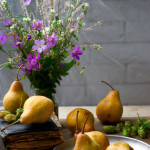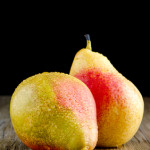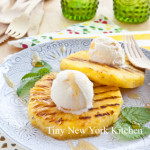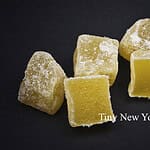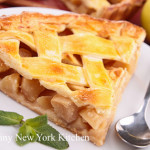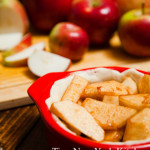In theory, it should make little difference to your health whether you cook for yourself or let someone else do the work. But unless you can afford to hire a private chef to prepare meals exactly to your specifications, letting other people cook for you means losing control over your eating life, the portions as much as the ingredients. Cooking for yourself is the only sure way to take back control of your diet from the food scientists and food processors, and to guarantee you’re eating real food and not edible foodlike substances, with their unhealthy oils, high-fructose corn syrup, and surfeit of salt. Not surprisingly, the decline in home cooking closely parallels the rise in obesity, and research suggests that people who cook are more likely to eat a more healthful diet.
“Work With What You Got!”
©Tiny New York Kitchen © 2019 All Rights Reserved
Going out for dinner on Valentine’s Day is a risky affair. Even the best restaurants can have “overload difficulties” on such a busy night where couples have expectations of restaurant perfection. A better way to manage expectations is to take control of them yourself. Food is a language of love. You know what you like and what your loved one likes. No need to worry about cheesy love songs or a perfumed soaked lady sitting next to you. Nothing says I love you more than taking the time to make a special meal for the person you love. Visit the local farmers’ market, butcher, or seafood shop to buy their favorite seasonal ingredients. Come up with a meal that celebrates love. Turn off the lights, fire up all the candles and put on your favorite music.
Keep it easy and made make it special. Plan out the meal from beginning to end to get organized and make sure you have a solid menu. If you’re not a seasoned cook make sure to keep it simple and I recommend not trying to make complicated dishes that you’ve never made before. Make it easy with three courses. Begin with a beautiful cheese plate. Embrace easy, big impact dishes. Start off with prosciutto-wrapped scallops finished with a squeeze of lemon. Warm things up with braised short ribs or steaks finished off with butter and herbs. Keep desserts simple, but sweet. Decorate bakery cakes with fresh fruit or edible flowers or warm up slices of pie and top with caramel sauce and a gourmet ice cream or try your hand at an easy dessert of chocolate pots de crème. Don’t forget that nice bottle of wine or champagne.
“Work With What You Got!”
©Tiny New York Kitchen © 2018 All Rights Reserved
Winter Citrus Fruit is a beautiful natural ingredient that will perk up the winter table with generous juiciness and vibrant vivacious hues. Citrus fruit have a beauty that cooks can incorporate into their winter meals. As an added bonus they are an excellent snack for that nagging sweet tooth. They can bring a bit of glamor to a winter fruit salad. Arrange oranges, clementine, mandarin, pomelo or grapefruit slices and you will have a sunny rainbow of goodness for breakfast or brunch. Nothing more is needed than perhaps a scattering of fresh mint or basil. These citrus also combine well with cranberries, raspberries and strawberries, adding burst of sunshine to yogurt bowls and smoothies.
Green salads love a bit of sunshine, too. Add citrus slices to a mixture of arugula, radicchio, endive and baby kale; add minced fresh herbs, such as basil, tarragon and chill. Add a bit of creamy goat cheese and dress it all up with a vinaigrette.
The versatility of citrus makes them a superstar winter ingredient. These beautiful fruits are low in calories, have a significant amount of dietary fiber and are a nice source of folate. Rich in vitamin A and C, Citrus provides healing, soothing benefits for eyes, skin, hair, and nails and many positively impact the aging process. Consuming citrus may possibly lower the risk of heart disease, prostate cancer and macular degeneration.
Let the sunshine in!
“Work With What You Got!”
©Tiny New York Kitchen © 2018 All Rights Reserved
There are almost as many varieties of pears as there are apples, but only a dozen or so are readily available in stores. Pears are related to apples, but are much more fragile and are more often eaten raw than cooked. They have fine white granular flesh and a core containing the pips (seeds). Most pears are wider at the bottom than the top, but some are apple-shaped, while calabash pears have an elongated neck, like a gourd. Pears tend to be less vividly colored than apples, usually varying from bronze to gold, green or yellow, although there are also some red-bushed varieties such as Red Williams and Forelle.
Anjou: These large pears have greenish yellow skin with small brown spots. The flesh is juicy and sweet. Suitable for eating and cooking.
Beurre Superfin: Large, with a tough golden green, russet skin, this is the perfect eating pear. Its flesh is sweet and juicy and it is less grainy than other pears.
Conference: First cultivated in the English country of Berkshire in 1770, these long, conical pears have remained a favorite because they keep so well. The yellowish-green skin with extensive russet turns more yellow when the pears are mature. The granular flesh is tender, sweet and juicy. Conference pears are excellent for eating and cooking.
Comice: This large, roundish pear is one of the finest of all pears, with creamy white, melting, very juicy flesh and a sweet, aromatic flavor. The thick, yellowish-green skin is covered with speckles and patches of russet. Comice are best eaten raw and they are delicious served with Camembert or Brie cheese.
Forelle: This beautiful golden pear has a dark red flush on one side. The grainy flesh is crisp, with a fresh flavor. Eaten raw, it goes particularly well with cheese, but is at its best when cooked.
Laxton’s Foremost: Yellow-skinned and lightly russet, this is one of the largest pears. Its creamy colored flesh is very juicy and granular. It does not keep well and, as it turns brown from the inside out, there may be no external signs that the fruit is past its best.
Packham’s Triumph: The first successful Australian pear was produced by Charles Packham in 1896 and remains a favorite. Slow-ripening, it is a largish dessert pear, with a smooth green, lightly russet skin that changes to yellow as it ripens. The soft white flesh is succulent and sweet, with a touch of acidity.
Red Williams: These pears have shiny, speckled skins, at first green with a red blush, turning to yellow flushed with red. The flesh is sweet and juicy.
Bartlett/Williams Bon Chrétien: These irregularly shaped pears are generally swollen on one side of the stalk. The speckled skin is golden yellow with russet patches and sometimes a red tinge. The delicious tender flesh is creamy-white and very juicy, and the flavor is sweet and slightly musky. Bartletts are suitable for cooking and eating, but unfortunately these superb pears do not keep well.
Winter Nelis: This roundish medium-size pear has thick, but tender greenish-yellow skin with cinnamon-brown russet and sometimes a pink flush. The creamy-white flesh is soft and very juicy, and the flavor is sweet. These pears can be cooked or eaten raw.
Perry Pears: With the demise of the most famous of the sparkling alcoholic pear drinks, perry pears have largely fallen into disfavor. A few small producers still press perry pears into juice, wine or “champagne” perry, but although there are still about 300 known varieties, you will never find these in stores. Perry pears are smaller than their dessert counterparts. Although they look delicious, they contain large quantities of tannin and taste bitter and astringent, whether raw or cooked.
Asian/Nashi Pears: There are many varieties of Asian pears, but their characteristics are very similar. They are round rather than a pear shape, the fruits have a golden brown russet skin and they have very crisp, white juicy flesh. The crunchy texture resembles that of an apple, but is more granular. It would be a shame to spoil the crisp texture by cooking. Asian pears are best eaten straight from the refrigerator, to be enjoyed as a “drink of the stalk”. They also make an excellent addition to fruit salads or savory winter salads.
Tientsin: These Asian pears from China and Korea are very similar to Asian Nashi pears in taste and texture. They are available when Asian pears are out of season. They look rather like elongated apples, tapering gently at both ends. The skin is pale yellow, slightly speckled with patches of light brown. The pure white flesh is exceptionally juicy and crunchy.
Hosui: These pears have much the same crunch and juiciness of the Tientsin pears, but look more like apples, with green-brown mottled flesh that tastes like a cross between an apple and an unripe pear.
Buying and Storing: Always buy pears when in perfect condition, as they deteriorate quickly. Once past their best, they become wooly and squashy and unpleasant. Test for ripeness by pressing gently; the fruit should give a little, but still be quite firm. Once ripe, eat within a couple of days. They can be kept at the bottom of the refrigerator for a few days. Store unripened pears at room temperature, where they will ripen in two or three days.
Preparing and Cooking: The majority of pears are eaten raw, by themselves or with a robust cheese such a Stilton or Roquefort. Pears Savarin, halved fruit filled with Roquefort mashed with a little butter are served chilled with double (heavy) cream and paprika, is a popular appetizer. Pears also make a good addition to winter salads. Whether or not to peel pears before eating raw is a matter of preference, but they should always be peeled before cooking. Pears discolor quickly once they are peeled, so rub the cut surface with lemon juice or place in a bowl of water acidulated with lemon juice. If the recipe involves cooking the pears in wine or sugar syrup, the fruit can be put directly into these to prevent them turning brown.
Most varieties of pears are suitable for cooking, but some are specifically designated cooking pears, although commercial production of these is now decreasing. If appearance is important, choose even-size, classic pear-shaped pears such as Comice, Conference or Bartlett. For whole poached pears, simply peel with a stainless steel vegetable peeler, leaving the stalk on. Use an apple corer to core the pears if you want to stuff them with nuts or dried fruit. Poach in port or red wine spiced with cinnamon, cloves and thinly pared lemon rind, or in a vanilla-flavored syrup. For sautéed or grilled (broiled) pears, peel and quarter the fruit and scoop out the cores with a melon baller. Sauté over a low heat in unsalted butter or grill (broil), turning once, watching very closely to avoid the fruit scorching.
Pears can be used in a wide variety of desserts, including tarts, mousses, soufflés, sorbets, and ice creams. They are also delicious grated into tea breads. Pears go particularly well with nuts, especially walnuts and almonds, in both sweet tarts and savory winter salads.
Like apples, pears complement game, particularly duck and hare, while venison garnished with pears is a German specialty. For additional luxury, the pears may be cooked in pear brandy, also known as Williamine, or pear liqueur. Pears can also be roasted with small game birds and then rubbed through a sieve and served as a sauce. A slightly more unusual, but delicious combination is lamb and pears, slow cooked in a casserole. Pears also feature in soups, most famously with watercress and also with garden peas.
Fruit vinegars have come back into fashion and steeping pears in vinegar to flavor it has a long history in country and farmhouse cooking. The vinegar is a rich golden color. It can be used in salad dressings, as part of a basting mixture when roasting rich meats, especially duck, or for deglazing the cooking juices after pan-frying liver or duck to make a sauce. Pear chutney is also a traditional rural favorite, not least because you can use hard, windfall pears that would otherwise have to be thrown away. Pears can also be steeped in brandy for several weeks to make a liqueur for drinking after dinner. A more modern variation of this is to steep the fruit in vodka.
“Work With What You Got!”
© Victoria Hart Glavin Tiny New York Kitchen © 2017 All Rights Reserved
Grilled pineapple is so very versatile because you can use it for savory or sweet, hot or cold dishes. Grill over indirect heat and the sugars in the pineapple concentrate bringing out a sweet and meaty fruit that is ideal for endless summer recipes.
6 Ways To Use Grilled Pineapple
Slice and serve with grilled pork or fish.
Cut into chunks and toss with salt and lime juice for a smoky fruit salad.
Muddle and use as the base for a sweet-savory cocktail.
Dice and mix with chopped cilantro and chiles for salsa.
Purée and spoon over vanilla ice cream or good Greek yogurt.
Top with ice cream or sorbet.
“Work With What You Got!”
© Victoria Hart Glavin Tiny New York Kitchen © 2017 All Rights Reserved
Just a few fresh berries add color and nutrients to a salad, cocktail, or mocktail.
Stock up on fresh berries, wash and freeze them in a single layer on a sheet pan. Then transfer to a freezer bag for future smoothies and baked goods.
Add a handful of berries to a parfait, with yogurt for breakfast or ice cream for dessert.
Gently fold berries into muffin and pancake batter. Cook a big batch and freeze some for easy breakfasts later.
Make into a savory salsa and serve as a dip or over grilled chicken or wild-caught salmon.
“Work With What You Got!”
© Victoria Hart Glavin Tiny New York Kitchen © 2017 All Rights Reserved
Crystallized ginger is fresh ginger that has been slowly cooked in sugar water and rolled in coarse sugar for preservation. It has a sweet, spicy taste and can easily be made at home.
“Work With What You Got!”
© Victoria Hart Glavin Tiny New York Kitchen © 2017 All Rights Reserved
Lattice Crust 101
Creating a lattice crust isn’t as difficult as it looks. Follow these easy steps and you’ll have a pretty and traditional looking pie.
Using a pastry cutter or knife, cut pie crust into 1 inch strips. Trim off the ends.
Lay on top of the filling, leaving a 1 inch space between each piece. Overlap each piece to form a lattice.
Secure the edges by pressing down onto crust with a fork. Trim off any excess dough.
www.tinynewyorkkitchen.com
“Work With What You Got!”
© Victoria Hart Glavin Tiny New York Kitchen © 2016 All Rights Reserved
The Best Apples For Apple Pie
It’s apple pie season and it’s important to choose the best apples for apple pie. Choosing the right apples for baking can be a daunting task. I mean, seriously, there are over 7,5000 apple varieties. When it comes to pie not all apples are created equal. Choose a mix of firm & tart and firm & sweet varieties. Doing this adds diversity and depth of flavor, while holding their shape during the cooking process. No one wants a mushy pie.
Braeburn: A Firm & Sweet/Tart Variety Originating from New Zealand, Braeburn has a skin that’s muted red with golden-yellow undertones and tinges of faint green. It produces a firm, crisp bite and offers a pleasing balance between sweet and tart. Firm to the touch and great for baking as well as eating raw. Excellent when paired with Honeycrisp. Can be found in most supermarkets.
Granny Smith: A Firm & Tart Variety Classic green apple is firm, slightly sour, and perfect for pie making. It’s available everywhere.
Esopus Spitzenburg: A Firm & Tart Variety This is an heirloom variety that has flavors bright enough to make an excellent snack or pressed into cider. You’ll find this variety at farmers’ markets and makes a delicious pie filling.
Northern Spy: A Firm & Tart Variety Northern spy is thought to be the best apple variety for pies. Difficult to find at supermarkets, but many farmers’ markets have them.
Idared: A Firm & Tart Variety This tart and spicy apple is bright red in color when fully ripe. Not so easy to find in supermarkets, but popular at pick-your-own orchards and farmers’ markets.
Pink Pearl: A Firm & Tart Variety This variety is delicious and you’ll want to seek this variety out. Difficult to find, but can be found at some pick-your-own orchards. Search online in your area for a place to Pink Pearl.
Ginger Gold: A Firm & Sweet Variety Ginger Gold is a baker’s champion. This delicately sweet and crisp variety works well in pies, muffins, and cakes. Can be found in most supermarkets during autumn.
Golden Delicious: A Firm & Sweet Variety This is a mild tasting variety and is best when paired with heftier flavors. Very popular in the U.S. and can be found in any supermarket.
Honeycrisp: A Firm & Sweet Variety This is a crisp and predominately sweet variety. Very popular in the U.S. and can be found in most supermarkets. Great when paired with Braeburn for pie making.
Jazz: A Firm & Sweet Variety Great for eating raw as well as pie making. From New Zealand and can be found in most supermarkets.
Jonagold: A Firm & Sweet Variety A cross between Jonathan and Golden Delicious varieties. Sweet and tart flavor and can be used on its own. Can be found in both supermarkets and farmers’ markets.
Pink Lady: A Firm & Sweet Variety The perfect combination of sweet and sour. Pink Lady is excellent for baking as well as eating raw. Can be found in supermarkets and farmers’ markets.
A Word About McIntosh Apples: Mcintosh variety is a popular choice for many bakers, but I don’t recommend them on their own if you’re using them for pies. They just don’t hold up well to heat and tend to cook down into a sauce before the pie crust is done cooking. If you love the flavor of McIntosh apples and just have to use them in pies then combine them with a much firmer variety like Pink Lady, Jonagold, Honeycrisp, or Northern Spy.
“Work With What You Got!”
© Victoria Hart Glavin Tiny New York Kitchen © 2016 All Rights Reserved

